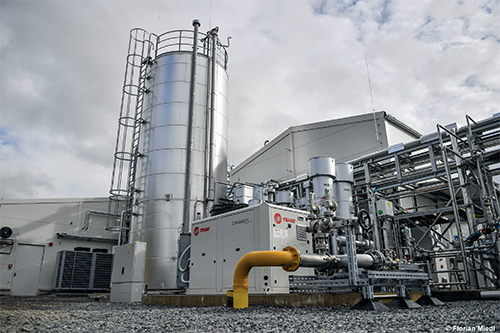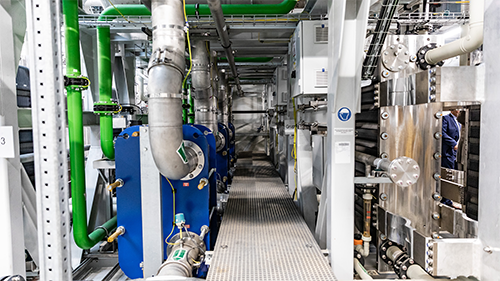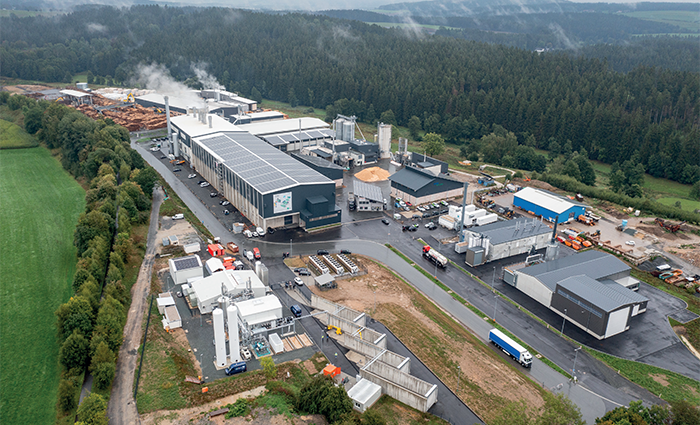How WUN H2 is uniting heavyweight industry players in the production of green hydrogen
Carbon-zero collaboration
WUN H2 is the operating company of a venture between Siemens Financial Services, the gas trading company Rießner-Gase and the utility company, Stadtwerke Wunsiedel (SWW). The project, to build one of the largest green hydrogen production plants in Germany, started approximately three years ago, and was officially inaugurated and ready to produce green hydrogen in September 2022. Today, up to 1350 tonnes of green hydrogen can be generated annually from renewable solar and wind power in the Wunsiedel Energy Park. Hydrogen is generated by an electrolyzer with a total capacity of 8.75 megawatts.
As Dr. Philipp Matthes, Joint Managing Director, explains: “The Wunsiedel plant includes a two-step compression system up to 500 bars. There is 500-bar storage and a filling station on-site. The intention is to have the hydrogen collected by trucks and delivered to local and regional, commercial and industrial customers. Additionally, the hydrogen can be distributed via a pipeline to a neighboring Combined Heat and Power (CHP) facility that provides process heat for wood pellet production. These currently run exclusively on natural gas, but we have the option to substitute significant amounts of the natural gas with our hydrogen to enable the decarbonization of these processes. Thirdly, there will be a hydrogen refilling station for trucks and commercial vehicles This option will be implemented by spring 2023 and enable the decarbonization of the mobility sector.”
Hydrogen is a key technology to energy transition. The innovative approach in Wunsiedel will enable greater independence from the grid. Dr. Thilo Rießner, Joint Managing Director, explains: “The electrolyzer produces a current that splits water into hydrogen and oxygen. If the electricity is produced by renewable sources, such as solar or wind, the resulting hydrogen is also considered to be renewable.
“We have always needed hydrogen, and have had to source it from elsewhere, usually from big chemical plants, and not always without difficulty. As a family-owned, medium-sized industrial gas company, we wanted a new source of hydrogen: one that is renewable. We encountered the project in Wunsiedel between SWW and Siemens, and the concept developed from there.”
Philipp continues: “This shareholder concept brings together Siemens, the big technology provider incl. its Financial Services arm, the sales partner with the gas knowhow, and the municipality to anchor all the local factors.” As such, the Wunsiedel green hydrogen project serves as a model for production. However, it is not without its challenges.
Philipp explains: “The biggest challenge is the lack of a regulatory framework for green hydrogen in Europe. There is the Renewable Energy Directive II which is currently under discussion with the European Union, but is yet to be implemented into law. This is primarily because there is currently no global trade in this product, and no industry or regulatory body has taken the step of providing an express standard or definition. Without one however, it is difficult to approach potential customers. In the absence of regulatory standards, what constitutes green hydrogen will need to be contractually agreed between the buyer and seller. At the moment, customers cannot be reassured of the real value of green hydrogen. That is one of the biggest problems. It prevents securing long-term contracts, without which it’s practically impossible to plan strategically. It makes everything challenging for the bankability of the project. That said, we have nevertheless been able to secure a non-recourse project finance scheme, which to our knowledge is a first, at least in Germany, maybe even Europe and worldwide. Siemens Financial Services played a key role here with its capabilities to combine the technical world with financial expertise.”
 Thilo continues: “New technology brings considerable uncertainty; banks prefer established market technologies. It was a challenge to secure this non-recourse finance from UmweltBank, which while exclusively financing ecological loan projects, did still rely solely on projected cashflows.
Thilo continues: “New technology brings considerable uncertainty; banks prefer established market technologies. It was a challenge to secure this non-recourse finance from UmweltBank, which while exclusively financing ecological loan projects, did still rely solely on projected cashflows.
“Another challenge is in achieving an affordable price for green energy. The markets are very volatile at the moment. A Power Purchase Agreement (PPA) is a long-term agreement between a renewable developer and a consumer for the purchase of energy. While they may have guaranteed good prices in the past, it’s very difficult to secure them at today’s prices.”
Building flexibility
In terms of the project’s future-proofing strategies, the Wunsiedel plant was designed to enable growth and an increase in production to up to 17.5 megawatts. This would be no mean feat, however, and will require sufficient off-take and compression system capacity. Philipp continues: “Part of our plan is to extract the waste heat produced by the electrolysis process and deliver it to neighboring facilities for their use. Furthermore, we aim to use the oxygen that is being produced. Due to its current low value however, the concept is still in development. It will be much easier to implement once we’ve doubled the size of the facility, as we’ll have a greater quantity to sell. The plan at the moment is to include oxygen in a nearby waste water facility’s processes to enable more energy efficiency. This will tie in with the overarching aim of WUN H2 which is to utilize all value streams: hydrogen, oxygen and heat.”
One of the main drivers for WUN H2 is to build up flexible energy loads by converting the available renewable energy into storable hydrogen, making it available for applications in mobility and industry. This is especially useful when, on sunny and windy days, more energy from renewable sources is produced than needed. As Thilo explains: “In roughly ten seconds, we can fully power the plant up or down, and react really quickly to changes in energy production.”
While the Wunsiedel plant is one of the biggest today, when contemplating future energy needs and hydrogen production, it’s unlikely to remain so, as the region is not a big metropolitan area, and in terms of what more can be achieved, there are limitations. That said, from a broader shareholder perspective, its impact is likely to be vast if the approach is replicated and implemented by other municipalities.
Looking forward, Thilo concludes that “the main thing is to ensure stable and reliable production. Then, of course, when everything is running smoothly, we can proceed to the next step and increase our output. The market is relatively new, so there are very few experts, and those experts are still learning. It will take some time to embed the knowledge that’s needed to ensure seamless operations for the future.”
www.wun-h2.de
